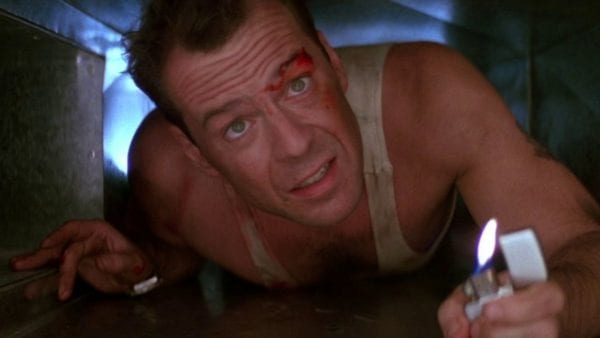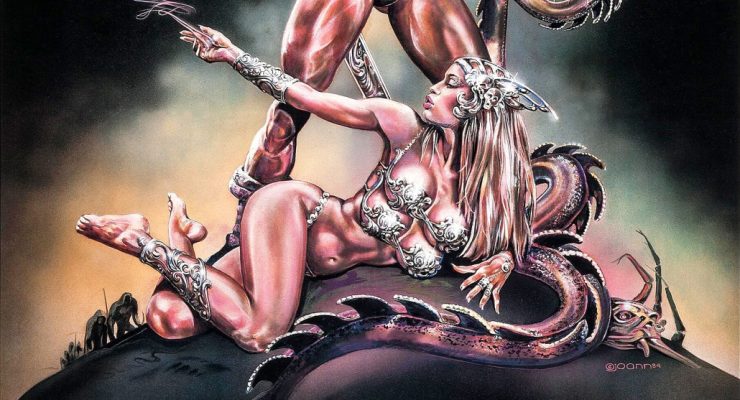Hasitha Fernando looks back at Die Hard as the action classic turns 35…

At the height of its popularity there was nothing that could quite match 80s actioners. Headlined by the likes of Arnold Schwarzenegger and Sylvester Stallone, Die Hard was released at a time when the action cinema was dominated by macho, muscle bound heroes spouting witty one liners and moustache twirling, scenery chewing villainy. We love ‘em all of course, but Die Hard brought with it, a form of gritty realism and believability that was essential to the action movie landscape at that time. But I digress, so without further ado, let’s check out some interesting facts that took place during the making of this seminal action film classic.
Die Hard was based on a detective novel inspired by a disaster flick
Die Hard was based on Roderick Thorp’s 1979 action thriller novel sporting the positively James Bondian title Nothing Lasts Forever. The book was a sequel to his 1966 effort The Detective, which was adapted into a movie featuring none other than Rat Pack legend Frank Sinatra. Whilst The Detective was more of a hardboiled detective noir type of deal, its companion piece was a suspenseful actioner set in a blazing high-rise. And this particularly unique setting was inspired by the 1974 disaster film The Towering Inferno. Thorp, who caught the flick a year later in cinemas, fell asleep one afternoon and saw a very vivid dream of man being chased through a skyscraper by armed assailants. It was this idea that Thorp used when crafting Nothing Lasts Forever.
Adapting the source material wasn’t an easy task
It’s quite a rarity to see the script development phase of a movie run smoothly, and Die Hard was no exception to the aforementioned rule. Screenwriter Jeb Stuart, who went on to write the critically acclaimed 90s actioner The Fugitive, was the first to take a crack at adapting Thorp’s property to the big screen. Producer Lloyd Lewin hired Stuart and gave him creative freedom, as long as he kept the Christmas-in-Los-Angeles setting of the original story, in his rendition. Stuart toiled relentlessly, working 18-hours per day on his script but he still struggled with a compelling central theme to the story. But one fine day, burned out from work Stuart had a heated argument with his wife, and after a drive around the block everything clicked together and he put it down to paper. When action veteran John McTiernan came into the picture, however, he requested a re-write of Stuart’s screenplay which he deemed to be joyless and lacked the fun factor. To achieve this task, script doctor and Commando scribe Steven E. de Souza was brought on board and it was de Souza that stuck on as the script underwent alterations up to and during filming.
Sinatra, Schwarzenegger & Stallone passed on the main role
As mentioned before, Nothing Lasts Forever functioned as a direct sequel to Thorp’s original novel and because Sinatra played the lead in the movie adaptation the producers of Die Hard were contractually obligated to offer him the role, however, since he was well over his 70s at that point the actor turned the offer down. Schwarzenegger, who had by that point become the go to actor for action heavy acting vehicles refused the part as well. This was because he felt typecast and wanted to branch out to comedy flicks. Other prominent actors who were also in the running were Sylvester Stallone, Richard Gere, Clint Eastwood, Harrison Ford, Mel Gibson, Al Pacino, James Caan and Paul Newman.
Bruce Willis’ fat paycheck proved to be a controversial subject
Although Bruce Willis’ name is now synonymous with the action genre, back when he was cast to play the gun toting do-gooder John McClane, he was mostly known for his work on the small screen. The most famous of which is the comedy drama television series Moonlighting, which ran for five seasons from 1985 to 1989, and earned Willis both an Emmy Award and a Golden Globe Award in 1987. So, when Willis was hired to headline a summer blockbuster actioner for a whopping $5 million – which was comparable to the paychecks of veteran actors like Dustin Hoffman and Robert Redford – it prompted people in the industry to question the controversial move; after all Willis only had one feature-length film to his name at that point. But all Willis’ naysayers were silenced and proved wrong when the movie debuted, as it catapulted the actor’s career into the proverbial stratosphere and transformed him into a bonafide action star.
Alan Rickman’s American Accent was worked into an iconic scene
Before his breakout role playing the villainous Hans Gruber in Die Hard, British actor Alan Rickman’s career was pretty much confined to his work in the theatre. Obtaining his training at the Royal Academy of Dramatic Art in London, Rickman eventually became a member of the Royal Shakespeare Company performing in classic, as well as, modern theatre productions. And it was during the Broadway theatre production of Les Liaisons Dangereuses, where he played the narcissistic Vicomte de Valmont, that Rickman caught the eye of producer Joel Silver and was asked to come in and audition. Unsurprisingly the talented thespian landed the role, introducing the world to a new breed of sleek, well-educated form of villainy. During production the producers and screenwriter de Souza were struggling to figure out a way to get both McClane and Gruber involved in a scene; before the film’s climactic conclusion. De Souza got the solution to his conundrum from Rickman himself, when he overhead the actor affecting an American accent. The writer put two and two together, and ended up crafting the brilliant sequence where Gruber disguises himself as an American citizen to get the drop on McClane.
The Legendary Catchphrase has its roots in old Hollywood Westerns
Yes, I’m talking about ‘that’ iconic profanity filled catchphrase uttered by John McClane himself. Inspired by the lingo of the ‘King of Cowboys’ Roy Rogers, the intension was to infuse a bit of the ol’ all-American flavor to McClane’s character as he went about dealing with Gruber’s men. The decision to use “Yippee-kay-yay” instead of “Yippee-ti-yay” however, was Willis’ choice alone. Good call sir.
Gruber’s fall was an unforgettable experience for Rickman
Remember Gruber’s genuinely shocked face in the movie, moments after he’s let go by McClane? Yeah, that was very real. Since director McTiernan wanted to add a sense of authenticity to the scene he told Rickman, who was suspended from a raised platform waiting to be dropped to an airbag below, that he’d be dropped at ‘the count of three’ but the actor was let go earlier, and that look of sincere shock was caught beautifully on film for our viewing pleasure.
Willis’ reputation prompted changes in the film’s marketing campaign
From the get go Willis’ casting in the flick drew some unexpected attention, which kickstarted with his hefty paycheck and worsened with his rather arrogant demeanor during interviews and press junkets. In his defense Willis has often stated that he wanted the media to focus on his acting, and not his personal life. But of course, things didn’t go too well in his favor as 20th Century Fox stepped in to change the movie’s marketing campaign – as they viewed Willis as something of a detrimental factor to it. As a result, the marketing campaign which featured him prominently early on was abandoned in favor of a Nakatomi Plaza-centric approach. Even the film’s posters were altered to focus on the iconic high-rise instead of Willis’ handsome mug. But as positive audience responses from sneak previews began pouring in, the advertising once again began to feature Willis more prominently.
Die Hard’s Box Office performance had low expectations initially
1988 was a pretty busy summer. Multiple successful action franchises were putting out their much-awaited sequels like Crocodile Dundee II and Rambo III. And comedies like Coming to America and Who Framed Roger Rabbit, which have been ear marked by industry analysts to become box office hits, were also debuting. In comparison Die Hard had an as-of-yet unproven action star who didn’t have a built-in audience headlining a non-franchise original IP. However, by the end of its theatrical run the movie grossed upwards of $ 140 million going on to become the 10th highest grossing release worldwide, and that too against some heavy competition.
An underdog actioner that redefined the genre
Prior to Die Hard’s release there were firmly established tropes pertaining to the action genre. Heroes were testosterone fueled, macho men with the ability singlehandedly take on an army of adversaries. Villains were one-dimensional, cookie cutter characters akin to caricatures. But Die Hard upended these norms and ushered in some much-needed changes to the genre. For starters, the flick introduced the world to the clever nemesis; one that used the brain instead of his brawn. And no one embodied this more elegantly and chillingly than Alan Rickman’s utterly brilliant Hans Gruber. The same goes for Bruce Willis’ turn as John McClane which gave audiences a relatable everyman hero who was imperfect and vulnerable. Of course, the franchise’s later sequels somewhat abandoned the trendsetting concepts mentioned above but there is no denying that Die Hard had a profound impact on the cinematic landscape and continues to be an inspiration for action filmmaking in general.
Hasitha Fernando is a part-time medical practitioner and full-time cinephile. Follow him on Twitter via @DoctorCinephile for regular updates on the world of entertainment.



















